|
|
The Protecting Veil of the Most Holy Mother of God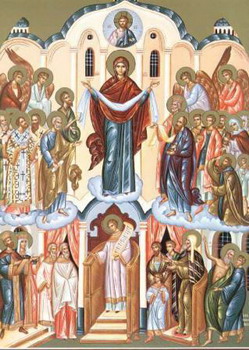 The Church has always glorified the most holy Mother of God as the Protectress and Defender of the Christian people, entreating, by her intercession, God"s loving-kindness towards us sinners. The Mother of God"s aid has been clearly shown times without number, both to individuals and to peoples, both in peace and in war, both in monastic deserts and in crowded cities. The event that the Church commemorates and celebrates today proves this constant protection of the Christian people by the Mother of God. On October 1st, 911, in the time of the Emperor Leo the Wise (or the Philosopher), there was an all-night vigil at the Blachemae church of the Mother of God in Constantinople. The church was crowded. St Andrew the Fool for Christ was standing at the back of the church with his disciple Epiphanius. At four o"clock in the morning, the most holy Mother of God appeared above the people with a veil spread over her outstretched hands, as though to protect them with this covering. She was clad in gold-encrusted purple and shone with an unspeakable radiance, surrounded by apostles, saints, martyrs and virgins. Seeing this vision, St Andrew gestured towards it and asked Epiphanius: "Do you see how the Queen and Lady of all is praying for the whole world?" Epiphanius replied: "Yes, Father; I see it and stand in dread." As a result, this commemoration was instituted to remind us both of this event and of the Mother of God"s constant protection whenever we prayerfully seek that protection, that shelter, in distress. The Church has always glorified the most holy Mother of God as the Protectress and Defender of the Christian people, entreating, by her intercession, God"s loving-kindness towards us sinners. The Mother of God"s aid has been clearly shown times without number, both to individuals and to peoples, both in peace and in war, both in monastic deserts and in crowded cities. The event that the Church commemorates and celebrates today proves this constant protection of the Christian people by the Mother of God. On October 1st, 911, in the time of the Emperor Leo the Wise (or the Philosopher), there was an all-night vigil at the Blachemae church of the Mother of God in Constantinople. The church was crowded. St Andrew the Fool for Christ was standing at the back of the church with his disciple Epiphanius. At four o"clock in the morning, the most holy Mother of God appeared above the people with a veil spread over her outstretched hands, as though to protect them with this covering. She was clad in gold-encrusted purple and shone with an unspeakable radiance, surrounded by apostles, saints, martyrs and virgins. Seeing this vision, St Andrew gestured towards it and asked Epiphanius: "Do you see how the Queen and Lady of all is praying for the whole world?" Epiphanius replied: "Yes, Father; I see it and stand in dread." As a result, this commemoration was instituted to remind us both of this event and of the Mother of God"s constant protection whenever we prayerfully seek that protection, that shelter, in distress.The Holy Apostle Ananias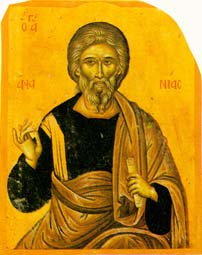 One of the Seventy, he was bishop in Damascus. In response to a vision from God, he baptised Saul, the future Apostle Paul (Acts 9), and courageously preached the Gospel in the face of all persecution, for which he was stoned to death in the city of Eleutheropolis. His holy relics were taken to Damascus, and later to Constantinople. One of the Seventy, he was bishop in Damascus. In response to a vision from God, he baptised Saul, the future Apostle Paul (Acts 9), and courageously preached the Gospel in the face of all persecution, for which he was stoned to death in the city of Eleutheropolis. His holy relics were taken to Damascus, and later to Constantinople.Our Holy Father Romanus the Melodist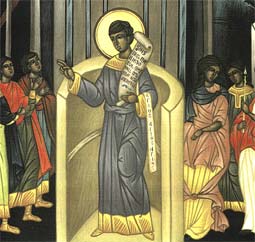 Born in the Syrian town of Emesa, he served as a verger first in Beirut and then in Constantinople at the cathedral, in the time of Patriarch Euphemius (490-96). Illiterate and with no musical training, he was despised by certain educated clergy. St Romanus prayed weeping to the Mother of God, and she appeared to him in a dream, held a piece of paper out to him and told him to swallow it. The following day was Christmas Day, and Romanus went up to the ambo and, with an angelic voice, sang: "Today the Virgin which has come down to us as the Kontakion of the Feast. All marvelled at the words of the hymn and at the singer"s voice. Receiving thus the gift of song from the Mother of God, Romanus composed more than a thousand kontakia. He died as a deacon of the Great Church in Constantinople in 530, and went to join the angelic choir. Born in the Syrian town of Emesa, he served as a verger first in Beirut and then in Constantinople at the cathedral, in the time of Patriarch Euphemius (490-96). Illiterate and with no musical training, he was despised by certain educated clergy. St Romanus prayed weeping to the Mother of God, and she appeared to him in a dream, held a piece of paper out to him and told him to swallow it. The following day was Christmas Day, and Romanus went up to the ambo and, with an angelic voice, sang: "Today the Virgin which has come down to us as the Kontakion of the Feast. All marvelled at the words of the hymn and at the singer"s voice. Receiving thus the gift of song from the Mother of God, Romanus composed more than a thousand kontakia. He died as a deacon of the Great Church in Constantinople in 530, and went to join the angelic choir.Our Holy Father John Kukuzelis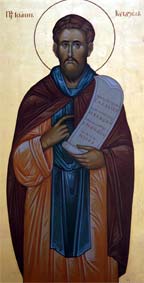 A Slav from Dyrrachium, he was taken as a young man to the School of Music in Constantinople, where he became a popular singer at the imperial court. Feafing the flattery and praise of men, he fled to the Holy Mountain and presented himself at the Great Lavra as a shepherd. As shepherd and monk, he lived in rare asceticism, and the Mother of God appeared to him twice. He entered into rest in the twelfth century. A Slav from Dyrrachium, he was taken as a young man to the School of Music in Constantinople, where he became a popular singer at the imperial court. Feafing the flattery and praise of men, he fled to the Holy Mountain and presented himself at the Great Lavra as a shepherd. As shepherd and monk, he lived in rare asceticism, and the Mother of God appeared to him twice. He entered into rest in the twelfth century.Our Holy Father GregoryA monk of the Great Lavra in the fourteenth century.
Martyr Michael, abbot in Armenia, and 36 Fathers with him (790)Martyr Domninus of Thessalonica (4th c.)Venerable Sabbas, abbot of Vishera (Novgorod) (1461)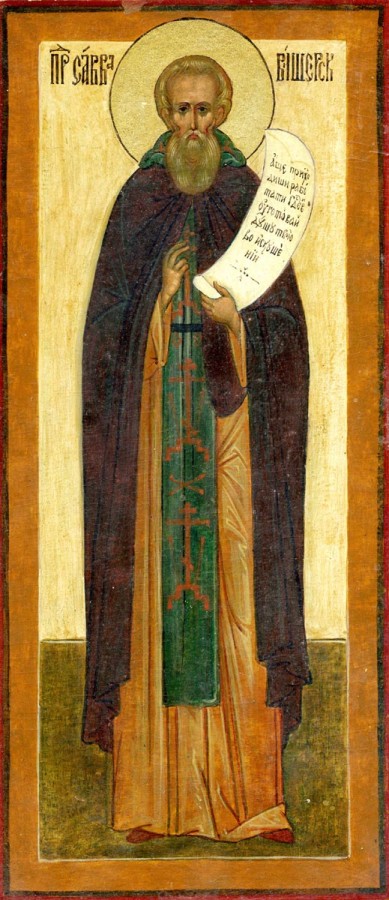 The Monk Savva of Vishersk was the son of the boyar-noble, Ivan Borozda, from Kashin. From childhood the monk was noted for his piety. He initially asceticised at the Tver Savvino wilderness monastery, where the brethren chose him hegumen. In shunning honours, the Monk Savva went off to Athos, where he toiled over the copying of Divine-service books. Upon his return from Athos he selected for his ascetic efforts a solitary place 7 versts from Novgorod at the banks of the River Vishera. Here, with the blessing of the Novogorod archbishop Simon, the monk in 1418 organised a small monastery in honour of the Ascension of the Lord. The Monk Savva set up a pillar nearby the monastery and asceticised upon it. He died in 1461 at the advanced old age of 80... The Monk Savva of Vishersk was the son of the boyar-noble, Ivan Borozda, from Kashin. From childhood the monk was noted for his piety. He initially asceticised at the Tver Savvino wilderness monastery, where the brethren chose him hegumen. In shunning honours, the Monk Savva went off to Athos, where he toiled over the copying of Divine-service books. Upon his return from Athos he selected for his ascetic efforts a solitary place 7 versts from Novgorod at the banks of the River Vishera. Here, with the blessing of the Novogorod archbishop Simon, the monk in 1418 organised a small monastery in honour of the Ascension of the Lord. The Monk Savva set up a pillar nearby the monastery and asceticised upon it. He died in 1461 at the advanced old age of 80...Miracle of the Pillar with the Robe of the Lord under it at Mtskheta (330); The Holy Equal-to-the-Apostles Emperor of Iveria Mirian and the Holy Empress Nana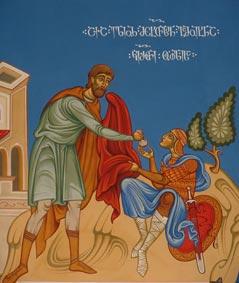 The Feast in Honour of the Chiton (Tunic) of the Lord and the Life-Creating Pillar – is the temple feast of the Mtskheta patriarchal cathedral in honour of the Twelve Holy Apostles, named the Sveti-Tskhoveli (which in translation means "Life-Creating Pillar"). According to the tradition of the Gruzian (Georgian) Orthodox Church, the Chiton (Greek word, in Latin "Tunic") of the Lord – the seamless garment of the Saviour (Jn. 19: 23) – came to the ancient capital city of Gruzia, Mtskheta, in the following manner... The Feast in Honour of the Chiton (Tunic) of the Lord and the Life-Creating Pillar – is the temple feast of the Mtskheta patriarchal cathedral in honour of the Twelve Holy Apostles, named the Sveti-Tskhoveli (which in translation means "Life-Creating Pillar"). According to the tradition of the Gruzian (Georgian) Orthodox Church, the Chiton (Greek word, in Latin "Tunic") of the Lord – the seamless garment of the Saviour (Jn. 19: 23) – came to the ancient capital city of Gruzia, Mtskheta, in the following manner...St. Melchizedek, catholicos-patriarch of Georgia (11th c.)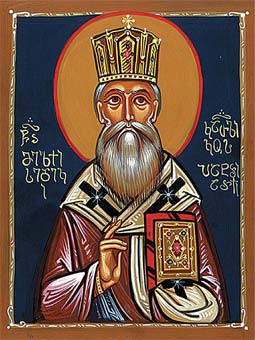 After the repose of Catholicos Simeon, leadership of the Georgian Church passed to Catholicos Melchizedek I. St. Melchizedek led the Church from approximately 1010 to 1030, during the reigns of Kings Bagrat III, George I, and Bagrat IV. It is believed that St. Melchizedek was the first Georgian Catholicos to be commemorated as Catholicos-Patriarch... After the repose of Catholicos Simeon, leadership of the Georgian Church passed to Catholicos Melchizedek I. St. Melchizedek led the Church from approximately 1010 to 1030, during the reigns of Kings Bagrat III, George I, and Bagrat IV. It is believed that St. Melchizedek was the first Georgian Catholicos to be commemorated as Catholicos-Patriarch... |